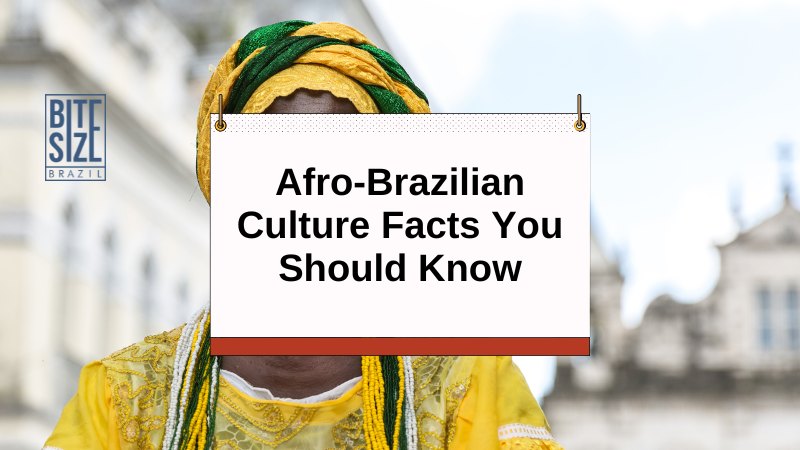Here's a fact: over 50% of Brazil's population identifies as having African ancestry.
This makes Brazil the country with the second-largest African diaspora in the world.
This heritage has shaped Brazilian society, from music and dance to religion and food.
And in this article, you’ll see 10 fields on which African heritage has a huge, and important, impact.
Well, starting with Brazilian culture in general
African heritage defines Brazilian culture, going back to colonial times.
The Portuguese trafficked millions of Africans to Brazil as slaves. (And here is a great series of books you might want to read about it if you know Portuguese – affiliate link). Despite hard conditions, the enslaved Africans kept their culture alive. This culture mixed with European and indigenous ones, creating a unique Afro-Brazilian identity.
This mix manifests in many parts of Brazilian life, like music, dance, religion, and food.
For instance, the rhythms and instruments of samba music have African roots.
Capoeira, a martial art, also shows African influence, blending dance, acrobatics, and music.
In religion, Candomblé is a big part of Afro-Brazilian faith. It mixes African spiritual beliefs with Catholicism.
This shows how African traditions survived colonial oppression.
And we’ll see a lot of it in the next sections.
Then we have capoeira, the Afro-Brazilian martial art
When I was a kid, I wanted to practice this martial art. It looked easy enough for a chubby little kid like me.
But is actually a form of self-defense, though it looks like a kind of dance.
It seems harmless, with people moving in a circle and doing acrobatics. But each move is a strike or defense, meant to protect the practitioner and surprise the opponent. This made it possible for enslaved Africans to practice without hassles.
Capoeira is a martial art from Brazil. It shows the strength and creativity of enslaved Africans. It mixes dance, acrobatics, and music into a powerful display. Developed by Afro-Brazilians, it was a way to defend themselves against slave owners.
Nowadays, capoeira is part and parcel of Afro-Brazilian culture. And it has many adapts around the world.
And the samba!
Samba is a vibrant rhythm that's key to Brazilian culture. It started in the late 19th century in Rio de Janeiro.
Back then, Samba was something only former slaves would play. Afro-Brazilians used music to express themselves, resist, and preserve their culture alive. In Rio's working-class areas, people played samba in streets and backyards.
It was something only “outcasts” and “brigands” would play. Even the great composer Chiquinha Gonzaga got a bad reputation for playing samba. She used to play guitar — an instrument associated with samba at first. And critics denounced for it.
Now, samba is the soul of Brazilian music, loved by people all over the world. The Brazilian Carnival is its biggest celebration. Thousands dance and play music in colorful costumes and on big floats.
In the field of religion, we have Candomblé
Candomblé is a vibrant Afro-Brazilian religion that started during colonial times.
Enslaved Africans had to adopt Catholicism, but they were clever. They linked Catholic saints with their gods, the orixás.
This blend of African and European faith created a unique faith that still thrives in Brazil.
At the core of Candomblé are the orixás, powerful beings that control nature and human life.
Each orixá has its own colors, foods, and natural links. And devotees worship them with music, dance, and offerings.
These rituals help followers connect with the divine. Through their rituals, they seek guidance and thank for blessings.
But Candomblé hasn’t thrived without obstacles. Its practitioners suffer with discrimination even now.
To give you an example...
I once visited a terreiro. The visit was for college work, and the terreiro was the place my coworker went to. She was a practitioner.
The following day, I wanted to talk to her about it at work. She refused to talk to me about it at work because our bosses might fire her.
That’s the level of persecution we still have today.
But Candomblé has endured past challenges and persecution. Today, it thrives as a vital element of Brazilian culture.
It's protected by law and celebrated as a symbol of Afro-Brazilian strength.
Scholars worldwide study Candomblé's history and syncretism. Papers and more papers highlight its big role in Brazil's culture and spirit.
The rich tradition of Afro-Brazilian cuisine
Afro-Brazilian cuisine blends African, European, and indigenous tastes and ingredients. This mix has created a unique food tradition.
Ingredients and cooking methods came to Brazil with the enslaved Africans. And these cooking methods and ingredients brought about many favorite Brazilian dishes.
Take, for instance, Feijoada.
Feijoada is a key dish in Afro-Brazilian cuisine. It's a rich stew with black beans and different types of pork.
If you search online, you'll find several origin stories for feijoada. One such story says that the Portuguese slave owners didn't eat all meat they had. That leftover meat became feijoada at the hands of the Africans.
(But that's not the only origin story, remember.)
Acarajé is another street food with strong African roots.
Black-eyed peas, onions, and salt form the base of these fritters. They're fried in A LOT of dendê oil, a type of palm oil used in West Africa.
Acarajé is often filled with vatapá, a creamy paste from bread, shrimp, coconut milk, and peanuts.
And, if it would like to know more Brazilian snacks, of all origins, follow this link.
Quilombos (kee.LOHM.boos): communities of resistance
Quilombos were refuges for enslaved Africans in Brazil. That's where they found freedom during the colonial era.
The Quilombos were safe havens for those fighting against the harsh slave system.
These communities let enslaved people live and build their own societies. They kept African traditions alive and created their own political and social systems.
Palmares was the most famous quilombo, located in today's Alagoas. It was home to over 30,000 people... and that in the 1600s! It was a key place of resistance against Portuguese rule for almost a hundred years.
Leaders like Ganga Zumba and Zumbi dos Palmares worked hard to keep their people free and in charge of their lives.
Today, many people from quilombos still live in these areas. They still fight for their rights to the land and their cultural heritage. But big companies and even the government do a lot to drive people away from those communities. That's shameful.
Afro-Brazilian Culture in Salvador, Bahia
Chances are, if you think of something "Brazilian", it comes from Rio de Janeiro or Salvador.
And Salvador is full of history and tradition. It shows the rich heritage of Africans in Brazil.
Pelourinho is at the city's core, a UNESCO World Heritage Site. It's famous for its beautiful colonial buildings and vibrant culture.
The area is alive with the sounds of samba during Carnaval. But it sports the beauty of capoeira during high season. And it is redolent with the smells of Afro-Brazilian food all year round.
I have even interviewed one of my coworkers. We discussed the five things five places you should visit here in Salvador.
To read more about Salvador and the interview, click here.
The Bahia Carnival
The Carnival is a big street party in Salvador and Rio every year.
It's a celebration of Afro-Brazilian culture, with samba and dances.
It's one of the biggest street parties globally. It brings and puts in the spotlight the Afro-Brazilian heritage and traditions.
The streets buzz with blocos afro, Afro-Brazilian carnival groups, during the Bahia Carnival.
Groups like Olodum and Ilê Aiyê play samba-reggae and other Afro-Brazilian music. Their beats and melodies fill the air with joy. And many people dance to them.
The Afoxé is a key part of the carnival. It's a religious procession honoring the orixás, Candomblé deities. People wear traditional white, carry sacred items, and dance to drums and cowbells.
And I am focusing on the Bahia Carnival for one good reason: I live here, so I can talk about it with propriety.
Afro-Brazilian culture in the letters and art
A while back, I found out that the most famous writer of Brazilian literature was actually Afro-Brazilian.
And I use the word "actually" on purpose.
As a kid, I would see pictures of Machado de Assis as if he was white. And recently scholars have debated whether his heritage influenced in his writing.
His works explored race, class, and social issues in 19th-century Brazil.
His novels and stories, like "Dom Casmurro" and "The Posthumous Memoirs of Bras Cubas," are famous for their deep insights.
Critics, literates, and the like praise these novels. We even had an American influencer who declared her love for Machado's works... and got famous for it.
In visual arts, Afro-Brazilian artists have their unique styles.
The naif (or naïve) art movement is big in the Northeast of Brazil. It uses bright colors, simple shapes, and shows everyday life.
These artworks often show scenes from Afro-Brazilian communities. They depict traditions, festivals, and religious practices. Naïve art lets Afro-Brazilian artists share their experiences, dreams, and hopes.
The legacy of Afro-Brazilian literature and art keeps inspiring new artists.
They work to keep this culture alive and moving forward. Their creations show the Afro-Brazilian spirit and creativity.
They make sure their stories and views are part of Brazil's identity.
But Brazil still struggles for racial equality
Brazil is famous for its vibrant Afro-Brazilian culture.
Yet, it still faces big challenges in racial equality and discrimination.
Brazil was the last country in the Americas to end slavery in 1888. The country's dark past still affects many Afro-Brazilians today.
The fight for equal rights and chances is ongoing. Afro-Brazilians deal with more poverty, joblessness, and violence than others. This makes their lives harder.
Recently, calls for affirmative action have become louder.
Activists want real steps to fix the deep-seated inequalities.
It's important to celebrate Afro-Brazilian culture to fight against discrimination. This culture is key in the fight against prejudice.
Fixing racial equality in Brazil is a tough task. It needs everyone's effort: society, government, and institutions. Brazil can become more inclusive and fairer. And it's simple. One way? By valuing Afro-Brazilian contributions and dismantling barriers that exclude people.
The fight for racial equality is a key human right. Everyone needs to support it.

